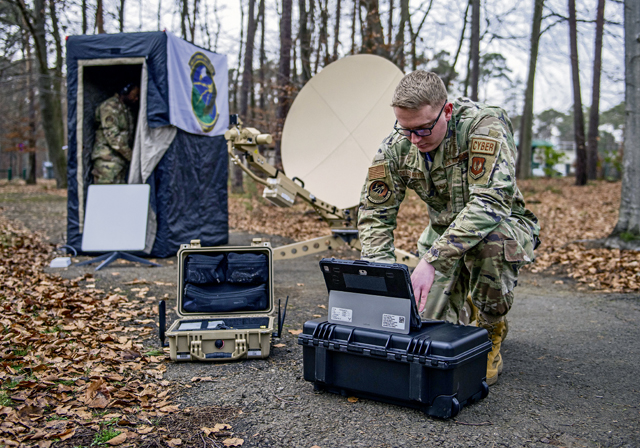
The 1st Air and Space Communications Operations Squadron recently achieved a major milestone for their multi-theater, all-network transport system, BlackNet, when it received its official Authority to Operate accreditation in July 2022.
BlackNet combines any method of communication like satellite, cell coverage, fiber optic or ethernet to create a meshed network and ensure users stay connected. Black networks are not new, but for USAFE-AFAFRICA, the speed to execute, proliferation over two continents, savings in circuit costs, equipment and manning, reliability and now the Authority to Operate, make the 1st ACOS BlackNet mission essential.
“The 1st ACOS’s BlackNet provides mass, maneuver, and assured communications, empowering warfighters access to critical information at the speed of need,” said Col. John J. Riester, 435th Air and Space Communications Group commander.
Necessity is the mother of invention, and BlackNet is no exception. One of 1st ACOS’s most important missions is to securely transport Intelligence Surveillance and Reconnaissance actionable data across Europe and Africa. To accomplish that mission, the 1st ACOS faced a challenge common for many service providers: The ability to establish a dedicated, resilient connection, especially outside of the continental United States.
As the 1st ACOS worked through this challenge, they realized that the COM industry’s “colorless core” might be a solution. The unit’s network engineers set out on a mission to integrate colorless core, and the notion of BlackNet was born. While brainstorming the building blocks of BlackNet, it became apparent to engineers that it would need to be a team sport. They contacted colleagues at the Defense Information Systems Agency, nearby Air Force communications squadrons, and satellite ground stations — all stakeholders in the mission to deliver mission critical ISR data.
The system came together in a way that is best summarized in a quote from its Chief Engineer, Mr. Billy Nix: “BlackNet is special because it can lay on top of any method of transport, whether SATCOM, LTE, COM internet, and even other DOD networks. It can be accessed as one specific transport network across Europe and Africa and deliver any service we want to connect to Ramstein Air Base.” Essentially, the 1st ACOS can deploy a BlackNet team with any method of transport to anywhere in Europe or Africa and deliver any enclave or service the warfighter would have access to.
BlackNet is engineered to be flexible and meet mission needs. It doesn’t matter if a team is out in the field with only cell data, military or COM satellite, Wi-Fi or a dedicated circuit; with a BlackNet router, they can deliver services. Even emerging technologies like SpaceX’s Starlink have been tested and used with BlackNet to deliver operational services to military warfighters in Europe.
“Deploying to install BlackNet has been simplified to just plug and play,” said Airman 1st Class Joshua Cummins, 1st ACOS infrastructure technician. “The configurations are made in the work center and quality checked before deploying. Airmen going [on temporary duty assignment] will coordinate with on-site personnel and with DISA for circuit extensions prior to installation.”
For some readers, BlackNet might sound familiar to another project being championed by the Air Force Air Battle Management System Digital Infrastructure or Integrated Warfighter Network. The intent of the Digital Infrastructure is to deliver a similar architecture which enables acquisition of interoperable systems that provide a network fabric across the globe, while facilitating mass, maneuver and denying adversary freedom of action in cyberspace.
“We started BlackNet based on a need to quickly provide ISR data to our most forward-based warfighters,” said Lt. Col. Phil Alvarez, 1st ACOS commander. “What we found through the process is BlackNet is a game-changer and epitomizes the Chief of Staff of the Air Force’s call to accelerate, change or lose. Our BlackNet has been in development for almost 10 years; its resilient, redundant, meshed capabili-ties survive in a disconnected environment and provide the flexibility and speed to meet both Agile Combat Employment and Joint All-Domain Command and Control concepts of operations. We believe our partners at the Air Force level will be successful in delivering the Digital Infrastructure and BlackNet will be the initial technology that paves that path. When ubiquitous transport and services are available across the globe to U.S. DOD warfighters at the speed of need, we will look back and know BlackNet originally employed in Europe and Africa is what got us there.”
BlackNet has proven integral in delivering services for operations and exercises across Europe, Africa, and Southwest Asia, as well as providing support for mobile, on the move communications. For example, BlackNet provided coalition networks across Europe for NATO’s integrated air and missile defense exercise, Astral Knight. Additionally, it was used to test Top Secret network connectivity in exercise Heavy Rain, where it successfully functioned in extremely difficult electromagnetic spectrum environments.
“BlackNet doesn’t support operations, it enables them,” Riester said. “The innovation 1st ACOS and BlackNet provide have transformed how we fight, not just for USAFE-AFAFRICA, but for the Air Force. We look forward to supporting our allies, and exponentially improving our warfighting communications, anytime, anywhere.”


